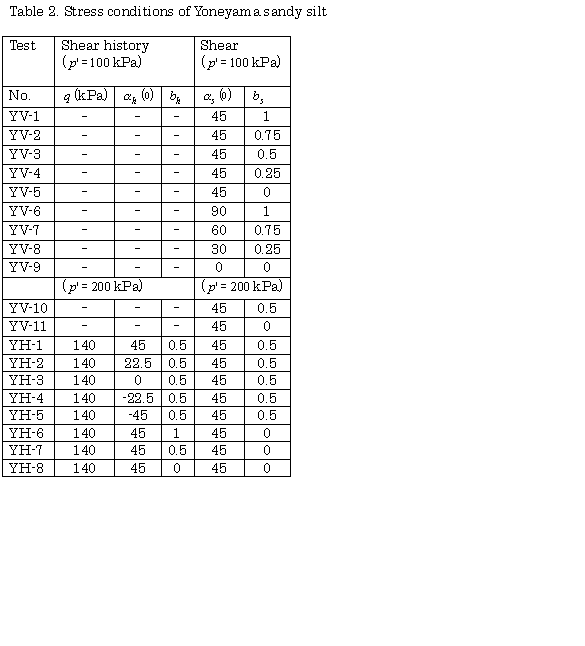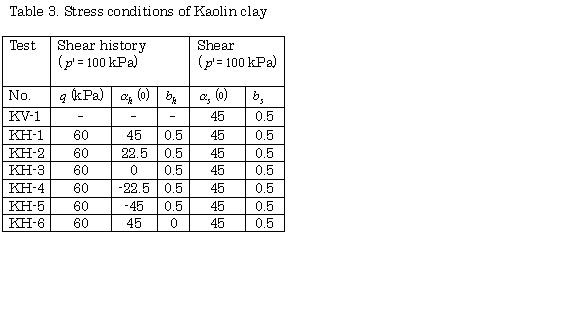EXPERIMENTS
The hollow-cylindrical torsional shear apparatus and the automatic control system used were the same as those introduced in Toyota et al. (2001).
Two types of cohesive soils were used in this study. One is a lateritic soil, which is referred to as Yoneyama sandy silt. It is the same soil used in Toyota et al. (2001). The other is Kaolin clay. The physical properties of the soils are summarized in Table 1 and the grain size distribution curves are shown in Fig. 1. Although Yoneyama sandy silt contains no less than 20\% sand, Kaolin clay does not contain sand and it is mainly clay. Although the consolidation time of Kaolin clay is five times longer than that of Yoneyama sandy silt, the liquid limit of Kaolin clay is the same as that of Yoneyama sandy silt.

Soil and de-aired water were mixed and stirred well to make a slurry. The water content of the slurry was about 80% in Yoneyama sandy silt and 100% in Kaolin clay. Pre-consolidation using this slurry was performed one-dimensionally in a mold under a vertical pressure of 45kPa in the case of Yoneyama sandy silt and 70kPa in the case of Kaolin clay. This vertical stress was selected from the minimum vertical stress at which the specimen can maintain its shape during trimming. The water content of the consolidated soil block was about 40% in Yoneyama sandy silt and 46% in Kaolin clay. The hollow-cylindrical specimen was made by trimming from this soil block.
The stress and strain parameters used in this research are the same as those used in Toyota et al. (2001). The values of α, b during the shear history and the shear, which are differentiated by using subscript letters, are referred to as αh, bh and αs, bs, respectively.
The torsional shear tests were performed on the specimens, which were subjected to four processes, as follows.
- The specimen was consolidated isotropically under a certain confining pressure pc'. The consolidation times, which were decided by the 3t method (Kamei, et al., 1987), were 3 hours in the case of Yoneyama sandy silt and 15 hours in the case of Kaolin clay. (Isotropic consolidation process)
- After completing the isotropic consolidation, the specimen was sheared under drained conditions with strain control. Shear stress was applied with a certain deviator stress qh under the stress conditions of p'=pc', αh and bh. The rate of shear strain, εs was about 0.0056 %/min in the case of Yoneyama sandy silt and 0.0012 %/min in the case of Kaolin clay. (Shear history process)
- Shear stress was unloaded to isotropic stress conditions equivalent to the stress conditions under the isotropic consolidation process. (Unloading process)
- Torsional shear tests, under stress conditions of p'=pc' and bs, were carried out under drained conditions with strain control. The rates of shear strain, εs are the same as those in the shear history process. (Shear process)
A back pressure of 200 kPa was applied to all specimens throughout all the processes to obtain full saturation, in which Skempton's B values (Skempton, 1954) were greater than 0.98. The stress conditions during the shear history process and during the drained shear process are summarized in Table 2 and Table 3. Table 2 summarizes the case of Yoneyama sandy silt and Table 3 summarizes the case of Kaolin clay.
These four processes are illustrated in Fig. 2.


RETURN